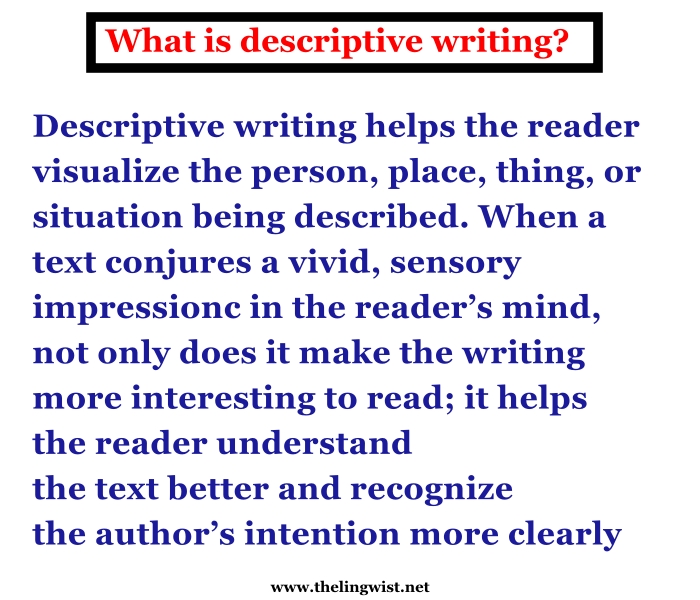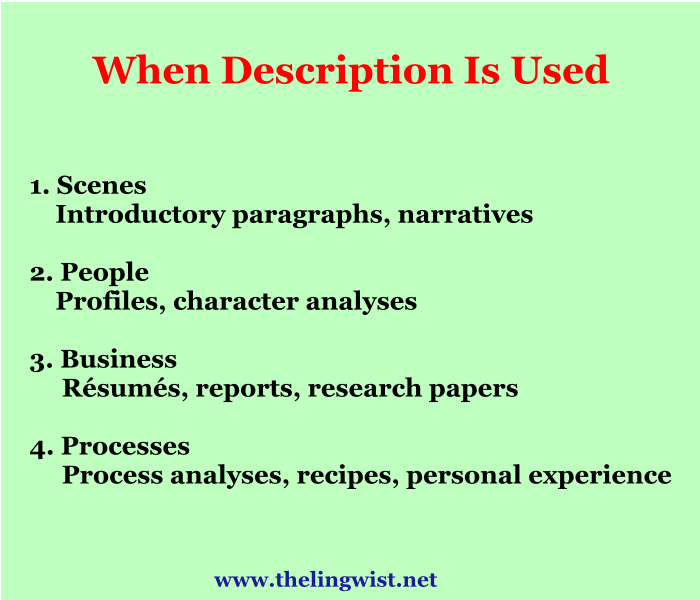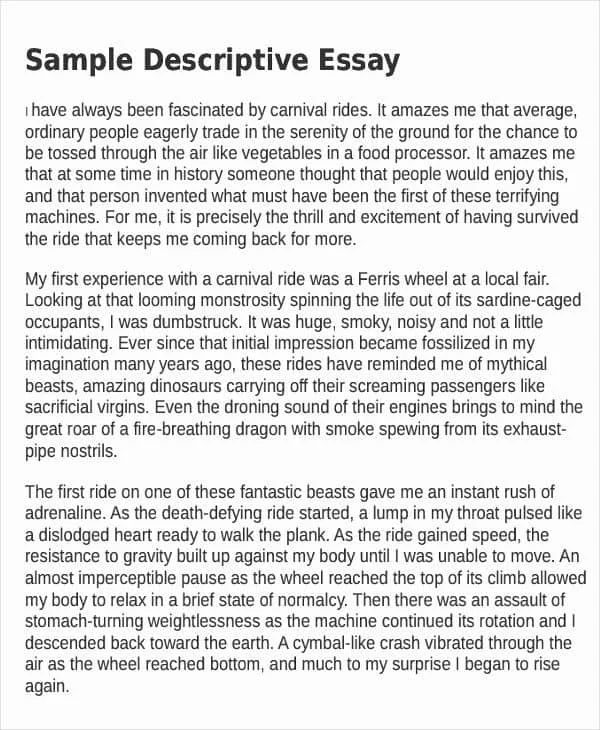1. What is description?
In descriptive writing, a description is a picture in words that helps the reader see, hear, taste, smell, or feel something that the writer has experienced.
Thank you for reading this post, don't forget to subscribe!
2. Steps and criteria
When we write a description, we must remember to:
– Begin with a hook that tells what the description is about.
– Use exact, vivid words to create a picture in the reader’s mind.
– Include important details about what you are describing.
-Put details in time order, spatial order, or in order of importance.
-Use sensory words that help your reader picture what you are describing.
– End in a way that wraps up the description.
3. When Description Is Used

4. What effective descriptive writing looks like
Authors of descriptive writing use a variety of styles and techniques to connect with readers, but effective descriptive writing often shares these characteristics:
- Vivid details. Specific details paint a picture in the reader’s mind and appeal to the reader’s senses. Descriptive writing may also go beyond creating a strong sensory impression to give the reader a “picture” of the feelings the description evokes in the writer.
- Figurative language. Tools of the writer’s craft such as analogy, simile, and metaphor add depth to authors’ descriptions.
- Precise language. General adjectives, nouns, and passive verbs are used sparingly. Instead, specific adjectives and nouns and strong action verbs give life to the picture being painted in the reader’s mind.
- Thoughtful organization. Some ways to organize descriptive writing include: chronological (time), spatial (location), and order of importance. Descriptive writing about a person might begin with a physical description, followed by how the person thinks, feels and acts.
See Also: Argumentative writing
5. Descriptive writing techniques
There are lots of different ways you can make your writing more descriptive. Here are a few of the most common descriptive writing techniques:
5.1. Metaphors
A metaphor is a descriptive technique that likens one thing to another. Take a look at these examples of common metaphors:
- My child is the light of my life.
- He’s the black sheep of our family.
- She’s a tornado that destroys everything in her path.
By stating that one object is another, you’re saying they share certain traits. You aren’t saying they’re indistinguishable or that they’re actually the same object; you’re expressing that the reader will encounter these specific traits in a very similar way in both objects.
5.2. Similes
A simile is like a metaphor. And yes, that was a simile.
Just like a metaphor, a simile describes something by comparing it to something else. The difference between the two is that a simile uses the word “like,” “so,” “than,” or “as” to make the comparison. For example:
- The building was as tall as Mt. Fuji.
- She drives faster than a NASCAR racer.
- They ate like a bunch of vultures.
With a simile, the comparison typically isn’t literal—it’s hyperbole that emphasizes the statement being made, much like it does with a metaphor. If you aren’t familiar with the term “hyperbole,” don’t fret—we’re covering it later on in this section.
5.3. Sensory writing
Sensory writing depicts a scene through your senses. Take a look at these examples:
- When the cool water splashed my face, the contrast made me realize just how red-hot my skin had gotten.
- Their home always smelled like freshly baked cookies; a constant cloud of chocolatey, sweet warmth wafted through the house.
- The sticky substance reached every centimeter of my skin, oozing into my pores and gluing my fingers and toes together.
As you can see, sensory writing typically incorporates other kinds of descriptive writing, like similes, metaphors, and hyperbole.
Freewriting is a great way to channel your senses and craft some spot-on sensory writing. Just open your word processor or notebook and start writing what you think, feel, or have experienced. There are no rules, no restrictions—just move everything that’s happening in your mind onto the page, walking through sensations like how you feel, what you hear, what you see, and what these sensations are driving you to do.
5.4. Hyperbole
When you use an extreme statement to make a point, you’re using hyperbole. Here are a few quick examples:
- It was a million degrees out yesterday.
- I haven’t heard that name in a hundred years.
- He was the sweetest boyfriend ever.
You know it wasn’t actually a million degrees, you most likely haven’t been alive long enough to not have heard a specific name in the past century, and surely there are many other boyfriends who are kind and thoughtful. But when you say things like this, you aren’t confusing or lying to your listener—you’re intentionally exaggerating to express just how extreme something was: It was very hot outside, you haven’t heard that name in a long time, and your boyfriend was very romantic.
5.5. Personification
It was a joyful bouquet. Each flower had a distinct, vibrant face and together, they were a happy choir of enthusiastic friends, ready to break into song at any moment.
We’re talking about flowers here and, as you know, flowers don’t have faces, voices, or friendships. But see how giving the flowers in this description human qualities like faces, voices, and interpersonal bonds gives you a clear image of the bouquet being described? It’s not just a collection of flowers; it’s a coherent group of fresh, healthy, colorful flowers.
5.6. Onomatopoeia
| Pop! | Bang! | Cha-ching! | Roar! |
Onomatopoeia are words for specific sounds. If you’ve ever watched the live Batman TV show from the 1960s, you’ve seen such onomatopoeia as “bam!” and “thwap!” flash across the screen during the fight scenes, creating a comic book-like feel. That’s what onomatopoeia does—it immerses you in the scene by giving it a “soundtrack.”
6. Rules for descriptive writing
| Effective Descriptions | Ineffective Description | Clumsy Modifiers | Questions to ask while drafting |
| 1. Have accurate nouns, verbs, and modifiers 2. Have words for readers’ sensory imagination 3. Tell readers what is important for them to know | 1. Uses dull, ordinary vocabulary 2. Lacks sensory information 3. Fails to follow a logical sequence 4. Provides unfocused, excessive detail | Dull Adjectives: good, bad, nice, great, different, happy Confusing placement: The damaged student’s car I fought off the dog in my pajamas. Finding it ransacked, I entered the house. | 1. What did it look like? 2. Where was it in relation to other things? 3. What did you smell? Hear? Taste? 4. How did you feel at the time? Afterward? 5. Physical sensations 6. Emotional sensation |
7. Sample of descriptive writing



